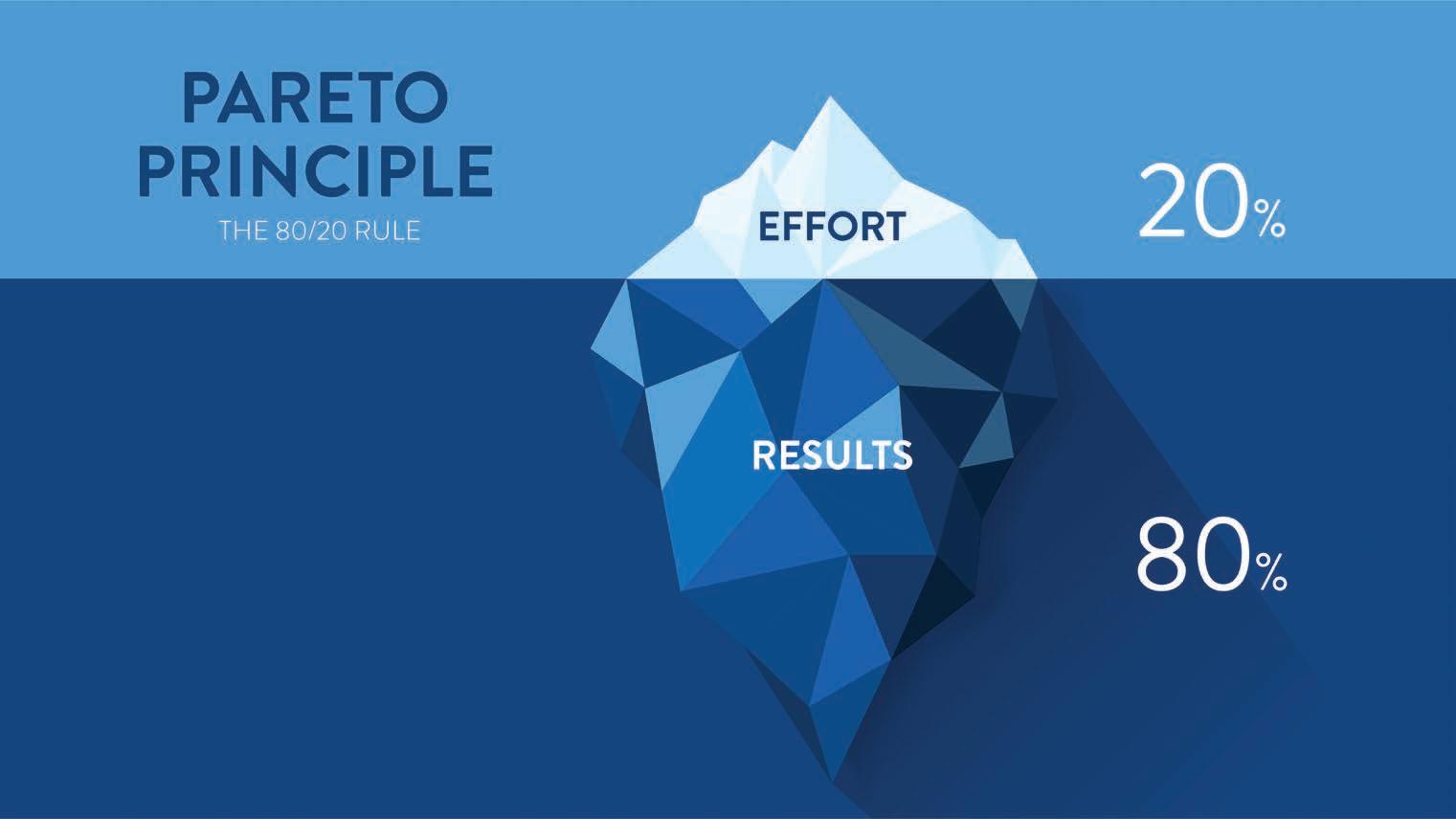
5 minute read
Pareto’s Principle, the 80/20 rule.
By Dwight Hodge
Leading a successful team and owning a thriving, profitable salon is not as complex as it may seem. Success is often perceived as a complicated and challenging journey, but it can be pretty straightforward. The misconception that a profitable salon must be complex is why so few salon owners achieve true success.
Increasing your salon’s revenue is an excellent example of how straightforward this can be. Let’s say I give you 90 seconds to list as many ways as possible to grow your salon’s revenue. How many could you list? 5, 10, 20?
Can you believe there are only three? Simply put, you can
1. Find more clients.
2. Your clients can spend more money.
And
3. Your clients can visit more often. That’s it!
Your ability to grow a thriving salon is directly related to your ability to simplify the complexities of business. It’s not just about distilling things to their simplest form; it’s also about knowing what to focus on and what to let go of.
You probably think, “Well, that’s great, but how do I know what to focus on?”
Think of Pareto’s principle. Pareto was an Italian economist who discovered the 80/20 principle, which bears his name. The principle states that 80% of your results come from 20% of your efforts. For example, in your salon, 20% of what you do gives you 80% of your results. But how do you know which 20%?
Let’s look at some examples of Pareto’s principle from your perspective as a salon owner.
Your clientele: Did you know that 80% of your revenue comes from 20% of your clientele? If you were to run a report for the last 12 months looking at how much each of your clients spent, your top 20% of clients would account for 80% of the salon’s total revenue.
You might be surprised at which of your clients sit in the top 20%. Often, you think it would be your clients with extensive colour work who spend more. However, they visit less frequently than your more regular clients, who visit for a weekly blow wave or every 4-5 weeks for a root colour, cut, and blow wave. These regular clients may spend a lot less than your high-spending colour clients per visit, but they visit often and spend a lot more over 12 months.
Your Profit and Loss statement: When you or your bookkeeper run a profit and loss report, you have an A4 page or move covered in rows and columns of numbers. It can be overwhelming as you dive into each line. I don’t advocate skimming over your financials; however, if you pick three lines to focus on, you can get a fast and clear picture of your business’s health.
A) Cost of sales: How much do you spend on colour and other products needed to perform your services?
Reviewing this line of your P&L lets you quickly assess if you’re overspending on colour and other products or if you have high product wastage.
B) Wage percentage: How much of your total revenue do you spend on employing yourself and your team?
Assessing your wage percentage tells you at a glance if your team is underperforming, if you’re paying them too much, or if your prices need to be adjusted.
C) Profit: How much money is left after paying all your expenses?
Although the purpose of running a business should not be all about money, your profit is a byproduct of running a successful business. Is your profit or bottom line healthy, or is your business on life support?
Knowing what to focus on can be challenging and overwhelming at first. In my experience, being curious is an excellent first step. When you come from a place of curiosity, you are open-minded and willing to understand other people’s perspectives. You also ask better questions and listen deeper, allowing you to gain more knowledge.
Seeking feedback from others accelerates your growth and development. You can seek input from a range of people. However, seek specific feedback from someone with knowledge and wisdom in the area you seek.
If you want to know what to focus on regarding your finances, it would be better to seek feedback from a bookkeeper or accountant.
If you’re focusing on team development, look at who in your network has developed a strong team culture and client experience. Knowing what to focus on is imperative to the success of your business because where your attention goes, your energy flows.
If you focus on opportunities to grow your salon, guess what? You will expend your energy on those opportunities and be more likely to succeed. If you focus on all the challenges and forces hindering you and your business, you’re doomed to live on struggle street or, worse still, fail in business.
Experience has repeatedly shown me that business owners who understand the business’s fundamentals and regularly focus on the right things have long-term success and profitable salons.
Seek feedback from others. Be willing to listen and learn what’s best to focus on for you and your salon. Remain curious and never stop learning.
The success you desire is on the other side of what you’re avoiding. Lean into the discomfort and find the simple, straightforward path to your success.
Stay curious,
Dwight
Dwight Hodge is an experienced leadership coach and mentor. His career spans over two decades as a business owner, company director and coach. He founded The Creative Leader, a leadership coaching practice that assists salon owners in propelling their leadership capabilities and business to the next level. Dwight is a salon owner, a member of the International Coaching Federation (ICF), holds qualifications in Business and Personal Coaching, is a Master Coach of Neuro-Linguistic Programming (NLP), and holds a Bachelor of Fine Arts (Sculpture) from the Victorian Collage of the Arts (VCA) dwight@dwighthodge.com










